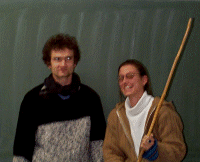
Abstract
![]()

![]()
The aim of the work was detailed geological mapping and kinematic interpretation of the study area in the eastern, slovakian part of the Pieniny Klippen Belt, which belongs to the Westkarpathians.
The complex deformation history was investigated by structural and strain analyses implemented of measurements of layering, joints, fold axes and slickensides from the mapping area.
Furthermore, data from the Geological Map 1:50.000 were taken for comparision.
No unequivocal age relationships were observed in the field and therefore the results of the study are compared to known kinematic events from the literature.
Three determined deformation stages and ages reflect the results of this study:
1. Late Cretaceous: NW-SE compression with dextral strike-slip fault.
2. Late Oligocene to Late Miocene: sinistral strike-slip fault caused by NE-SW/NNE-SSW compression.
3. Late Oligocene to Middle Miocene: local event, E-W directed extension with resulting normal faults caused by vertical compression.
The investigated data reveal another principle strain, which is E-W directed, but could not be correlated to events in the literature.
The resulting trajectories from the Geological Map 1:50.000 show a sinistral strike-slip fault defining the boundaries of the Pieniny Klippen Belt. Thus the structure of the layering in the map represents the Late Oligocene to Late Miocene event.
Additionally detailed strain analyses were performed only in a two-dimensional way, because the outlines of the Klippen were taken for investigation. Consequently only a general NW-SE direction of the resulting ellipsoides from the analysis was recognized. This direction is parallel to the strike of the Klippen and their associated shearzones. A clear interpretation of these facts would be only possible with known inital position and form of the Klippen.
![]()